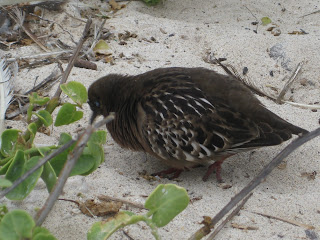We sailed north overnight to Genovesa Island, one of the most isolated islands in Galápagos. The island is home to a large number of seabirds and the biggest colony of red-footed boobies. We had the enviable task of trying to identify the abundant species of birds and selecting which of the birds to our left, our right, above our heads and next to our feet to observe.
We headed out at 7am to Darwin's Bay for a 1.5km trek on coral sand and slabs of lava. A juvenile sea lion was curled up on the beach when we arrived:
 |
| Juvenile sea lion |
Galapagos doves were searching for food while the juvenile swallow-tailed gulls were whining very loudly for more food.
 |
| Galápagos dove |
 |
| Swallow-tailed gulls L: juvenile R: adult |
 |
| Adult with very conspicuous fleshy red eye rim and white tip on bill |
From the beach, a path led us through the colonies of red-footed boobies and we quickly learnt that in the case of birds, the infants can look different from the juveniles which also differ from the adults. The females and males of the same species could also look different.
 |
| Red-footed booby |
 |
| Infant red-footed booby snuggled against mummy |
 |
| An awkward looking juvenile red-footed booby which is losing its white feather |
 |
| Sari with juvenile Great frigatebird |
Sometimes, the curiosity of the birds got the better of them:
 |
| Is this food? |
The trail led us to lava rocks and a small lagoon, where we saw more birds such as herons:
 |
| On cliff at Genovesa Island Photo credit: Martha |
 |
| Sharks Photo credit: Sari |
 |
| Whitetip reef shark Photo credit: Sari |
 |
| Blue chin parrotfish Photo credit: Sari |
 |
| Photo credit: Sari |
After lunch, some of us went kayaking along the cliffs while others snoozed.
In the afternoon, we set off in the dinghies to observe the cliffs.
The yellow-crowned night-herons hid in the nooks while marine iguanas and crabs scaled the cliffs. The cactus finches hopped about the prickly pear cacti. Birds flew above our heads.
 |
| Sea lion and yellow-crowned night-heron |
 |
| The poor sea lion has a deep scar across its right eye and face |
 |
| Prince Philips' Steps |
 |
| Red-footed booby |

2 eggs were laid each time, with the stronger chick killing the weaker one when they hatch - the cruel truth of "the strongest survive".
Video: Nazca booby nesting while hatching eggs
We also saw the short-eared owl which also testified to Darwin's revolution theory. Due to the lack of predators in the Genovesa Island, the short-eared owl no longer had to feed nocturnally and is active during the day.
 |
| Short-eared owl |
We left the island as the sun began to set.





No comments:
Post a Comment